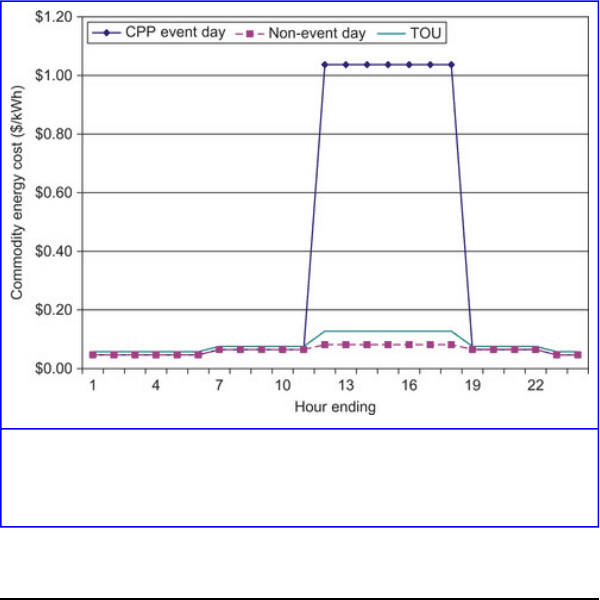Sioshansi F.P. Smart Grid: Integrating Renewable, Distributed & Efficient Energy
Подождите немного. Документ загружается.

metering and ratemaking infrastructure required to implement
such pricing were not in place at the time.
In view of these conditions, the California legislature in
March 2001 agreed to fund the installation of interval meters
for customers with maximum demand greater than 200 kW
(approximately 25,000 were installed throughout the state,
mostly at the three major investor-owned utilities, or IOUs).
In parallel, the California Public Utility Commission (CPUC)
initiated proceedings that resulted in the three IOUs filing
voluntary dynamic price structures, in the form of CPP, along
with several DR programs, in 2004 for customers with
interval meters.
The CPP tariffs were originally voluntary rates targeted at
customers with maximum demand greater than 200kW, who
were the first to receive hourly interval meters. The rates were
designed in conjunction with existing default tariffs
consisting of time-of-use (TOU) demand and energy charges.
Customers receive discounts on non-event peak-period prices
in return for facing considerably higher peak prices on a
limited number of “critical” days. However, following the
guidance of the CPUC, the utilities are transitioning toward
default CPP rates for all customers of size greater than 20 kW
of maximum demand, beginning with the largest customers
(e.g., those with maximum demand greater than 200 kW) with
voluntary opt-out to new TOU rates.
4
4
Designs for real-time pricing are being explored and will likely be
implemented in future years.
In addition to CPP rates, the utilities also offer a range of DR
programs. These generally include three types: 1) traditional
emergency, or reliability-based programs in which customers
591
receive capacity-based payments in return for agreeing to
curtail usage at short notice during infrequent emergencies; 2)
demand response programs offered by third-party DR
aggregators (including the statewide capacity bidding
program, or CBP, and individual aggregator contracts); and 3)
demand bidding programs offered to individual customers
(DBPs).
5
CPP events are generally announced on a
day-ahead basis, while the DR programs (other than the
reliability-based programs) generally offer both day-ahead
(DA) and day-of (DO) notice options.
5
As PG&E transitions to default CPP, it is renaming the rate “peak-day
pricing” (PDP). It is also transitioning DBP to PeakChoice, a flexible
bidding program with a variety of notice and payment options.
As of the summer of 2009, enrollments in each of the various
rates and programs generally ranged from a few hundred to
more than a thousand customer accounts (enrollment in
SDG&E's new default CPP rate was nearly 1,600), where the
average customer size typically ranged from about 200 to 500
kW. Total enrollment in CPP in 2009 exceeded 2,700
customer accounts, while enrollment in the aggregator
programs exceeded 4,000 customer accounts. Enrollment in
the DO option of the aggregator programs was generally
much larger than for the DA option, with approximately 70%
choosing day-of products, presumably due to larger capacity
credit payments.
To provide some perspective on the California electricity
market, the state has a population of some 36 million
residents, who are served by three major investor-owned
utilities (IOUs), several large municipal utilities (e.g., Los
Angeles Department of Water and Power and the Sacramento
592

Municipal Utilities District), and a number of smaller utilities.
PG&E, the largest IOU by area, serves approximately 5
million customers in regions ranging from north of the
relatively mild San Francisco Bay area to the hot and dry
central valley. Its system peak demand in 2009 was
approximately 19 GW. SCE serves a similar number of
customers, but with generally warmer weather, reached a
peak of about 22.4 GW in 2009. SDG&E serves 1.4 million
customers in the southern-most part of the state, reaching 4.5
GW in 2009.
Average bundled electricity prices for the large commercial
and industrial customers analyzed in this analysis ranged from
$0.11 to $0.14 per kWh across the three major utilities in
2009. These prices, which continue in part to reflect the
financial fallout from the 2000/2001 crisis, are substantially
higher than U.S. average prices.
6
6
Data from the Energy Information Administration suggest that average
retail prices for commercial and industrial customers in California were
24 to 40% higher than for the United States as a whole.
CPP Customers, Tariffs, and Event
Characteristics
This section describes the customers who participated in the
California CPP programs in 2009, the nature of the tariffs,
and the number and timing of the events called.
Customer Enrollment by Industry Type
In order to assess differences in load impacts across various
customer types, program participants were categorized
593
according to seven broad industry types, plus a category for
other/unknown. The industry groups are defined as follows
according to the applicable two-digit NAICS codes:
1. Agriculture, Mining & Construction: 11, 21, 23
2. Manufacturing: 31–33
3. Wholesale, Transport, Other Utilities: 22, 42, 48–49
4. Retail stores: 44–45
5. Offices, Hotels, Health, Services: 51–56, 62, 72
6. Schools: 61
7. Entertainment, Other Services, Government: 71, 81, 92
8. Other or unknown
Industry types 4, 5, and 7 include customers that are typically
thought of as commercial-types, while industry type 2
contains all manufacturing customers. Industry type 3
typically includes a number of water and/or sewage utility
customers that often turn out to be quite price responsive.
CPP enrollment by industry type, in terms of numbers of
customer service accounts (SAID) and percent of load (using
the metric of customers' maximum demand), for each of the
utilities is summarized in Table 12.1. Enrollment in CPP at
PG&E fell somewhat from 760 accounts in 2008 to 650
customer service accounts in 2009, after having expanded
from 337 accounts in 2006 and 656 accounts in 2007.
7
The
total load of the customer accounts enrolled in CPP, measured
as the sum of individual customers' maximum demands,
amounted to nearly 400 MW. The Manufacturing; Offices,
Hotels, Health, and Services; and Schools industry groups
594

made up the bulk of PG&E's CPP enrollment, measured by
the share of maximum demand.
7
Enrolled “customer accounts” are defined as the number of “service
agreement identification numbers,” or SA_IDs. In some cases, a single
“customer” will have more than one SA_ID, such as a supermarket or
retailer that has multiple facilities at different locations throughout a
utility service area.
Table 12.1
CPP Enrollment by Industry Type—Customer Accounts and Share of Load, by
Utility
Number of SAIDs % of Max kW
Industry Type
PG&E SCE SDG&E PG&E SCE SDG&E
1. Agriculture, Mining &
Construction Manufacturing
39 24 19 6% 4% 2%
2. Manufacturing 167 221 222 34% 49% 15%
3. Wholesale, Transport, Other
Utilities
67 54 266 8% 18% 20%
4. Retail stores 42 35 128 3% 7% 7%
5. Offices, Hotels, Health, Services 127 44 481 25% 7% 36%
6. Schools 159 99 267 14% 13% 9%
7. Gov't, Entertainment, Other
Services
49 8 190 9% 1% 11%
8. Other/Unknown 7 0%
TOTAL 650 485 1,580 100% 100% 100%
Source: Braithwait et al. [5].
SCE's enrollment in CPP has continued to expand, from just
15 customer accounts in 2006 to 44 accounts in 2007, 201
accounts in 2008, and 485 in 2009. Total maximum demand
of customers enrolled in 2009 nearly doubled to
approximately 283 MW. Manufacturing and Wholesale,
Transportation and Other Utilities industry groups made up
the bulk of CPP-participating load at SCE.
8
595

8
The relatively smaller number of CPP participants at SCE through 2009,
as well as the different mix of industry types (e.g., more manufacturing
customers), has largely been due to the presence of a rate, described
below, that consists of a notably higher CPP price, but a highly
discounted summer peak demand charge, which has attracted a number
of very large and flexible customers.
Nearly 1,600 customer accounts out of the original 1,800
customers who were defaulted onto the new CPP rate in 2008
continued to participate in default CPP at SDG&E in 2009,
declining to opt out to the new otherwise applicable
time-of-use rate.
9
Customers were offered bill protection for
their first year, such that their bill under CPP would be no
greater than under their otherwise applicable tariff. Since no
CPP events were called in 2008, bill protection was extended
to 2009, which may have encouraged customers to remain on
the rate. Offices, Hotels, Finance, and Services; and
Wholesale, Transportation and Other Utilities industry groups
accounted for more than half of SDG&E's 611 MW of CPP
load.
9
Customers of size greater than 20 kW were eligible for the new CPP rate
if they met the interval data recorder metering requirement and had been
on a demand response program previously. Otherwise, only customers of
size greater than 200 kW were assigned to the default CPP rate in the
first year.
CPP Tariffs
The CPP tariffs at the three utilities differ somewhat in design
and application, both across utilities and across rate classes at
the individual utilities. For example, SDG&E's default CPP
rate is a commodity tariff that applies only to the commodity
596
portion of customers' bills (e.g., they continue to pay for
distribution services under a standard tariff). It specified the
commodity prices for on-peak, semi-peak, and off-peak
periods on CPP event days and non-event days directly. In
contrast, PG&E implements CPP through a surcharge that is
applied to energy consumed during the on-peak period on
CPP event days, and credits are applied to energy consumed
in on-peak and part-peak periods on non-CPP days. Similarly
to SDG&E, SCE specifies a CPP price that applies to the
generation component of customers' charge for on-peak
energy consumption on CPP event days, but offsets that
charge through a discount on the summer on-peak demand
charge.
In general, the voluntary CPP rates consisted of peak-period
prices of approximately $0.80 per kWh on up to 15 event
days, with corresponding reductions in non-event energy
prices and/or demand charges to maintain expected revenue
neutrality. SCE offered a second alternative rate targeted to
large flexible customers that set a CPP price of more than
$2.00 per kWh in return for a large discount on the summer
peak demand charge.
The new default CPP rates (including the one in effect at
SDG&E in 2009) typically include event-day on-peak energy
prices that exceed $1.00 per kWh, while discounts on
non-event energy prices and/or demand charges can be as
large as 20 to 30%. Figure 12.1 illustrates the daily pattern of
commodity energy prices under the SDG&E default tariff on
CPP event days and non-event days, along with a comparable
profile for the alternative TOU rate. The CPP on-peak price
on event days is approximately 10 times the level on
non-event days, while the default CPP prices in all other time
597

periods are less than those for the alternative TOU rate. The
latter feature illustrates the potential for customer bill savings
under the CPP tariff; customers pay somewhat lower prices
most of the time in return for facing very high on-peak prices
on a limited number (e.g., up to 15) of summer weekdays.
Figure 12.1
SDG&E TOU & default CPP price profiles—Event Day and Non-Event Day.
CPP Events
Table 12.2 lists the CPP event days for each of the utilities in
2009. PG&E and SCE each called 12 CPP events (PG&E's
first event was a test event), while SDG&E called 8 events.
The utilities often called events on different days, though
there was some overlap, particularly in the last week of
598

August. PG&E's events started earliest in the summer and
ended earliest in the season, while SDG&E's events did not
begin until late August and extended into late September. One
of the events occurred on a Saturday.
Table 12.2
CPP Events, 2009
Date PG&E SCE SDG&E
6/18 1(Test)
6/29 1
6/30 2
7/13 3
7/14 4
7/15 2
7/16 5
7/17 3
7/20 4
7/21 6
7/22 5
7/27 7 6
7/28 7
8/10 8
8/11 9
8/18 10
8/20 8
8/27 11 9 1
8/28 12 10 2
8/29 3*
8/31 4
9/1 11
9/2 12
9/3 5
9/4 6
*
Saturday.
599

9/24 7
9/25 8
*
Saturday.
Analysis Methods
Estimation of customer load response to event-based dynamic
pricing is relatively straightforward compared to, for
example, static TOU rates or the effect of modestly changing
flat prices over a number of years. In the case of dynamic
pricing, hourly load data are typically available for a
relatively compact period of time, such as four summer
months, and for both days on which consumers faced
relatively low non-event prices, and on days on which they
faced high CPP prices. As a result, customers' loads on
non-event days may be used as comparison, or control, loads
for measuring their load reductions on event days, to the
extent that they can be adjusted for weather and day-type
effects.
The hourly load data for enrolled customers may be used at a
variety of potential levels of aggregation. The most
straightforward approach is to aggregate all of the customer
loads up to the program level and use that data to estimate
overall load impacts. However, that approach hides the
potentially rich variation in load response across specific
customers or customer types (e.g., across industry types or by
location). Largely for that reason, our approach involved
using load data at the individual customer level and separately
estimating customer-specific regression models for each
participating customer. The resulting customer-level
estimated load impacts can then be combined or summarized
600
